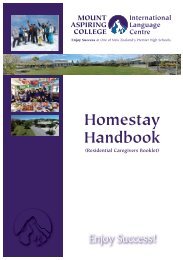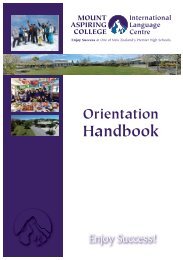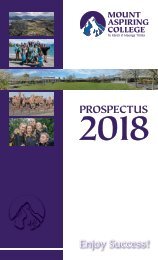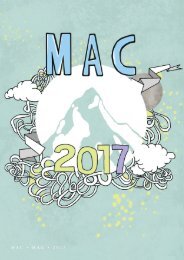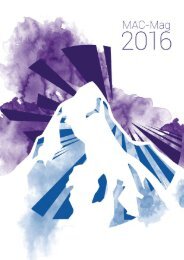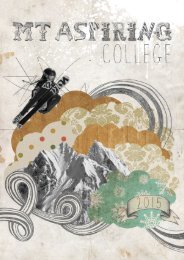MAC Magazine 2019
Mount Aspiring College's annual publication including all the goings on at our school, in Wanaka in the South Island of New Zealand.
Mount Aspiring College's annual publication including all the goings on at our school, in Wanaka in the South Island of New Zealand.
Create successful ePaper yourself
Turn your PDF publications into a flip-book with our unique Google optimized e-Paper software.
STUDENT WRITING<br />
68<br />
New Zealand has many introduced species that have both<br />
positive and negative impacts on our native environment.<br />
Early settlers have introduced a number of these animals<br />
and plants. Five of the most impactful species are rabbits,<br />
mustelids, deer, cattle and pine trees.<br />
Rabbits were introduced to New Zealand in the 1830s to make<br />
it more like the English countryside, where they were shot as<br />
a recreational sport. However in areas such as Central Otago<br />
rabbits have eaten much of the expensive grass supplied<br />
for cattle by farmers as well as burrowing out lots of dirt and<br />
making the ground unproductive and unstable. As they can<br />
reproduce up to six babies every two months they have<br />
become more of a pest. Currently, nationwide, rabbits eat<br />
almost $50 million worth of grass every year so some people<br />
have invented ways to try to limit their numbers. Unfortunately<br />
it would be almost impossible to completely eradicate them<br />
without causing damage to other innocent animals and plants.<br />
Methods to eradicate them have been those such as shooting,<br />
poisoning and hole plugging. Hole plugging is when the<br />
rabbits hole is blocked with dirt and rocks so that the rabbits<br />
can’t escape to get food. They eventually starve to death.<br />
However some more insightful ideas were attempted such as<br />
introducing their natural predator mustelids to hunt them.<br />
Mustelids such as stoats and ferrets were introduced in the<br />
1870s to help control the ever growing rabbit population.<br />
Although rabbit numbers stabilized for many years, native birds<br />
and eggs were killed because they were a defenseless target<br />
that would make for an easy meal. As a result of this many of<br />
these native species are now endangered and millions of<br />
dollars worth of government funding is being poured into<br />
trapping and poisoning mustelids. The goal is to make New<br />
Zealand predator free by 2050, so some islands and sanctuaries<br />
are purely dedicated just to keep them alive for that day. From<br />
that though another problem may arise. With all of the mustelids<br />
gone from here rabbit numbers may rise again uncontrollably.<br />
Another issue is 1080. Currently agencies such as DOC use the<br />
controversial poison, 1080, to kill these predators. As 1080 is<br />
large scale drop, many people are opposed to it because other<br />
animals like deer also die from the poison.<br />
New Zealand has many species of deer, most of which were<br />
introduced in the mid 1800s. Deer came to introduce hunting<br />
as a sport in the country. However deer thrived in the alpine<br />
environments of the southern area, and by the 1930s, paid<br />
deer cullers were employed to kill hundreds of thousands<br />
of deer. Deer were killed mainly because of the damage in<br />
the bush they were causing, purely as a result of their size<br />
and destructive nature. Deer culling continued on late into<br />
the 1900s until it was eventually stopped when deer farming<br />
began in Central Otago. Nowadays deer farming makes<br />
millions for New Zealand through the export of meat and<br />
also the antler velvet which is used in medicine worldwide.<br />
We have the largest deer farming industry in the country<br />
in Central Otago and New Zealand is currently the largest<br />
industry in the world with approximately one million deer<br />
inside the fence. Still there are many wild deer but there is no<br />
need to eradicate them as their numbers are kept steady by<br />
recreational hunters such as myself. Though there are many<br />
deer in New Zealand sheep and cattle outnumber them 20-1.<br />
We try and try so hard to fit in<br />
So much time is spent becoming ‘perfect’<br />
All this time we try to figure out who we are,<br />
who we want to be<br />
Never realising the answer was standing before us all the while<br />
We are who we are<br />
Every one of us unique<br />
In each and every way<br />
Everything we do<br />
The choices we make<br />
They outline our future and show us who we truly are<br />
The person truly in our heart and soul<br />
JEMMA BRAKE, 9SP<br />
Sheep were introduced to New Zealand by Captain James<br />
Cook in 1773, the very first time a European strode our<br />
shores. Cattle came not long after in the early 1800s. Since<br />
then they have become by far the biggest industry in the<br />
country and their products such as meat, wool and milk<br />
have become world famous. However lots of native bush<br />
has been cleared for them to graze on grass and in Central<br />
Otago especially, thousands of dollars worth of water is<br />
being used for irrigation. On top of that these animals<br />
can pollute the air and the waterways. The methane that<br />
comes from cows (poo, fart, burp) is a greenhouse gas<br />
and emissions are contributing to climate change. Poo can<br />
also end up in rivers and streams leading to heaps of our<br />
waterways being deemed to be un-swimmable. On a high<br />
note, farmers have made lots of money out of their animals<br />
and many people are employed because of them, such as<br />
shearers, farm workers, factory employees and vets. This<br />
leads to sheep and beef being the two biggest industries in<br />
the country ahead of forestry.<br />
The forestry industry is built around pine trees which were<br />
introduced to New Zealand in the 1870s by Californian gold<br />
miners. They were planted to make an easily sustainable<br />
wood and paper supply for the influx in population of the<br />
area due to the Central Otago gold rush. Because they grow<br />
fast and tall, and seed often, they became a very invasive<br />
species that quickly spread out across the land suffocating<br />
other plants from the sunlight, and invading native habitat.<br />
Eradication methods include group fellings, poisoning and<br />
if the situation is completely uncontrolled then forestry NZ<br />
may buy the land and log it themselves. Nowadays there<br />
are approximately two million pines (1,575,900 forestry<br />
and about 450,000 privately planted); most of which are<br />
logged and then shipped overseas to be made into either<br />
paper, furniture or planks. Although New Zealand’s forestry<br />
industry supplies only 1.1% of the worlds wood it makes $5<br />
billion for our economy, as well as employing over 20,000<br />
people. However almost 7% of NZ’s land area is planted up<br />
with pines, much of which used to be native bush. Luckily, as<br />
of <strong>2019</strong> though, the local population of pine trees is quite<br />
small and fully under control. Thankfully they no longer<br />
pose a deadly threat to the surrounding forest and habitat.<br />
On a whole New Zealand has seen its fair share of introduced<br />
species, most of which have varied effects on the native<br />
area and are difficult to keep under control. The planning<br />
needed when introducing a new animal or plant needs to<br />
be monumental, and unfortunately our native environment<br />
was not ready for some of these species. Thankfully, because<br />
of modern technology and insight some of these unwanted<br />
species are being eradicated, making New Zealand a better<br />
home for our natives.<br />
TOM SIDES 8RN<br />
Fishing<br />
The boat slides through the water. We soon get<br />
to our favourite fishing spot. The boat slides<br />
away from the reef so we cruise back over the<br />
reef and bait up again.<br />
Suddenly I feel a tug. Another one comes - then<br />
I strike. I have got one, so I flick the switch and<br />
the reel pulls it up. It is a bluenose. We gaff it<br />
and put it in the chilly bin.<br />
We head to a different spot where you catch<br />
blue cod.<br />
We get heaps. We start to gut the fish and have<br />
a little fish while we do that. We cruise back into<br />
shore, pack up and drive back to Wanaka.<br />
FLETCHER DAVISON 7BH






